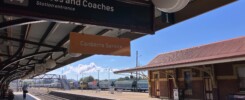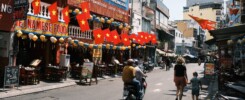The big question for any photographer before going on a trip is what gear to bring. Lugging around too much stuff can become cumbersome, especially in hot climates, cramped public transport or on extended hiking trips. On the other hand, travelling to an exotic destination might be a once-in-a lifetime opportunity to shoot a wide range of subjects. What’s the point of owning all these marvellous toys if you don’t bring them? I do in fact carry a boatload of electronics every day, so I would like to share some of the joy and the pain of travelling with gear.
First, let me explain quickly how we ended up in Kuala Lumpur. As we are travelling with a “Round The World” ticket by One World, our options regarding flights are numerous yet finite. On our way from Sydney to Hanoi, we had to change in Kuala Lumpur, Malaysia. We took our chance and decided to extend our layover to four days so we could get an impression of this megacity. And let me tell you, I’m glad we did! Not only is KL a fantastic gateway to Asia, but an interesting destination in its own right with rich culture, impressive architecture, and culinary delights.
Are we connecting any dots in KL? Not really – Anna’s clarinet stayed in its case and we did not meet anybody. However, wandering the streets of Kuala Lumpur, I remembered one of the finest photography bloggers of the recent past, Ming Thein, is based here. This gentleman is just as gifted a photographer as he is a writer. Actually, instead of calling him a blogger, the term essayist would do him more justice. His philosophical musings about everything photography combined with his clean, minimalist photographs left a deep mark on my own aesthetic vision. For both his meticulously crafted essays as well as his fine art inspired street photography, I regard Ming as a role model and an inspiration. But there is one more thing: As much as Ming is an artist and a philosopher, he is a gearhead, too. This makes him even more likable, in my opinion.
Photography per se and tinkering with photo gear can be seen as two separate passions. There are highly talented photographers who don’t even know what sensor is in their camera. And then there are the so-called pixel-peepers who obsess about the latest and greatest cameras, the highest resolution sensors, and the sharpest lenses, but miss to tell actual stories with their tools. Anyway, for some reason, people seem to enjoy reading about camera gear, so I will tell you about my choices here.
I am primarily a documentary-style stills photographer who enjoys capturing moments as they unfold. For this purpose, I rely on the Fujifilm X system, a mirrorless digital camera system with excellent manual controls, ergonomics, and colour science as well as a good selection of lenses. My primary stills camera for this trip is the Fujifilm X-T3, a robust weather sealed camera that is suitable for quiet concert situation as well as for inconspicuous street photography sessions. In addition, I shoot video, especially at concerts. For this purpose, I brought the Fujifilm X-S20 which allows me to record entire concerts thanks to its excellent battery life and unlimited video recording. So, while during most concerts, my S20 sits on a tripod (a shame given its excellent stabilization), my T3 serves double duty: It takes all the stills with the odd video in between. For the latter, I mostly use the fabulous Fujifilm XF 50-140 2.8 (my only stabilized lens) for the close-up shots. The other lenses I use, depending on the location, are the Viltrox 13 1.4, the Fujifilm XF 35 1.4, and the Fujifilm XF 60 2.4. My default workhorse lens, however, is the Fujifilm XF 16-55 2.8, that lives on the S20 most of the time.
The above setup with two bodies and five lenses along with a Sirui ST124 tripod is the bare minimum that allows me to shoot photo and video simultaneously at an event. What else is in my bag? For audio, I use a Zoom H2n recorder for concerts, an off brand lav mic for interviews and Sennheiser IE100 Pro earphones for monitoring. In addition, I carry a bunch of filters (Hoya Polarizer, ND 8, ND32, ND1000), a drone (DJI Mavic Mini 4 Pro) and an Action Camera (DJI Action 4) as well as a Sirui AM223 mini tripod. All the small bits and bobs live in tech pouch, and the entirety of my electronics including my 16″ MacBook Pro M1 Pro go into one of the most amazing backpacks I have ever had: the Shimoda Explore V2 35. Hauling a large amount of gear from A to B in this bag is a breeze. However, for more casual outings, the weight and bulk of my stuff is way too much, and a good backpack cannot change this. For my next trip, I will definitely look into getting an EDC, an every-day-carry bag for a minimalist setup of one body and one or two lenses.
Speaking of minimalist setups – there is one item I use for documenting our travels I have not yet mentioned, since I don’t use it as a “serious” camera: the iPhone. Is it a substitute for a professional camera? No. Do the photos have pleasing colour, detail, and editing latitude? Most certainly not. But it IS the best pocketable camera that shoots ok stills and pretty decent video for the moments when there is no time to set up a “real” camera. Because sometimes, the most remarkable moments, the most interesting stories to share happen between the shoots. This is when life unfolds.
As for Kuala Lumpur: I have genuinely enjoyed exploring this huge, hot & humid city, tasted its numerous delicious dishes that are inspired by so many different cultures (Nasi Lemak and Roti among others), tried and learned to love Durian ice cream, did some shopping (Private Stitch for the win!), marvelled at Batu Caves, gazed from one of the highest towers in the world over to the second highest building on earth. Oh, and I swam in a rooftop infinity pool on top of our apartment block. And during all of these adventures, I used my entire array of cameras and lenses, Fujifilm, DJI, and Apple. Can you tell which one is which?






























